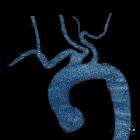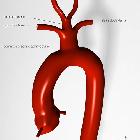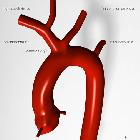gemeinsamer Ursprung Truncus brachiocephalicus und linke Arteria carotis communis


















Bovine arch is the most common variant of the aortic arch and occurs when the brachiocephalic (innominate) artery shares a common origin with the left common carotid artery.
A bovine arch is apparent in ~15% (range 8-25%) of the population and is more common in individuals of African descent.
A related variant, also known as truncus bicaroticus, is the origin of the left common carotid artery from the brachiocephalic artery but not sharing a true common origin, which occurs in ~9% of the population. Sometimes this can be difficult to distinguish from a common origin because the left common carotid artery arises within 1 cm of the origin of the brachiocephalic artery.
Clinical presentation
This common variant is asymptomatic most of the time. In rare cases of head and neck surgery, e.g. tracheostomy, it can be a risk factor for injury and cause complications . In combination with an aberrant right subclavian artery it can cause a dysphagia lusoria.
History and etymology
The name stems from the similarity of this variant with that of a normal bovine arch. A true bovine arch (as found in cattle) has a common single brachiocephalic trunk which trifurcates into bilateral subclavian arteries and a single bicarotid trunk. This variation is very rare in humans.
Presumably somewhere in the animal kingdom is an animal whose aorta actually branches like the so-called bovine pattern. Proposed names are feline/canine/lapine arch.
The term truncus bicaroticus is also not consistent and can be misleading as the branching pattern not only includes the right and left common carotid artery, but also the right subclavian artery.
Siehe auch:
- Anomalien des Aortenbogens
- Arteria carotis communis
- left common carotid artery originating from the brachiocephalic trunk
- Truncus arteriosus communis
- true bovine arch
und weiter:

 Assoziationen und Differentialdiagnosen zu Truncus bicaroticus:
Assoziationen und Differentialdiagnosen zu Truncus bicaroticus:


